Developing Business Strategy Model for EU Dairy Industry
VerifiedAdded on 2021/02/20
|68
|22424
|484
Report
AI Summary
This report focuses on developing a business strategy model to achieve sustained competitive advantage for the dairy processing industry in continental Europe. It begins with an introduction outlining the current challenges and the need for strategic models within the dynamic business environment. The report emphasizes the importance of strategic planning, innovation, and sustainability in the dairy sector. The literature review explores various business models and their impact on competitive advantage. The research methodology section details the research type, philosophy, approach, design, and data collection methods. Data analysis is conducted to support the research objectives. The report aims to address the research questions by identifying ways business models add advantages, merging traditional standpoints with business literature, and examining the business model proposition for sustained competitive advantage. The conclusion and recommendations offer insights into implementing the strategic model and enhancing the competitive position of dairy processing industries. The study emphasizes the need for qualified personnel and the adoption of strategic models to improve operational processes and achieve long-term organizational goals. Overall, the report provides a comprehensive analysis of the EU dairy industry and offers practical strategies for achieving and maintaining a competitive edge.
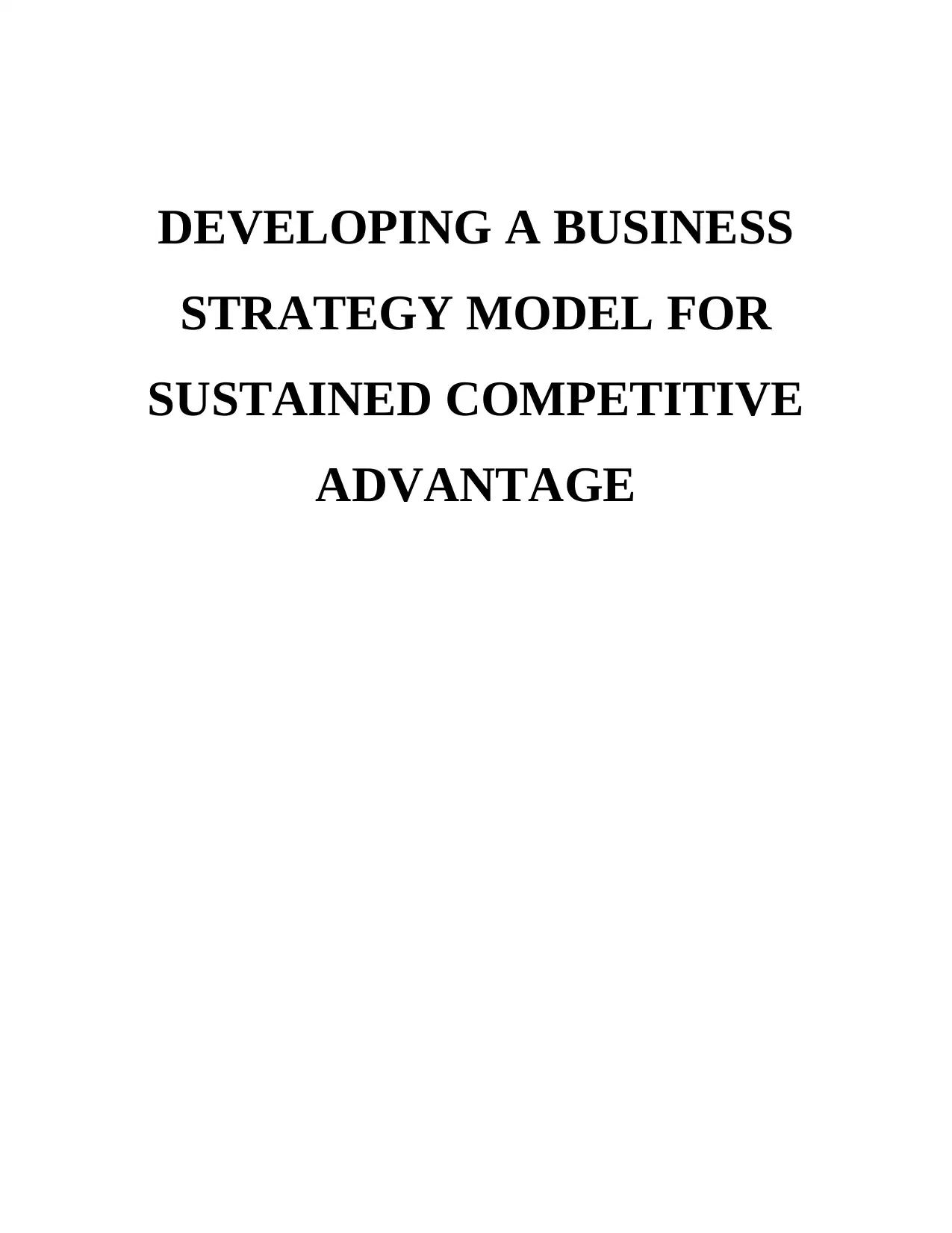
DEVELOPING A BUSINESS
STRATEGY MODEL FOR
SUSTAINED COMPETITIVE
ADVANTAGE
STRATEGY MODEL FOR
SUSTAINED COMPETITIVE
ADVANTAGE
Paraphrase This Document
Need a fresh take? Get an instant paraphrase of this document with our AI Paraphraser
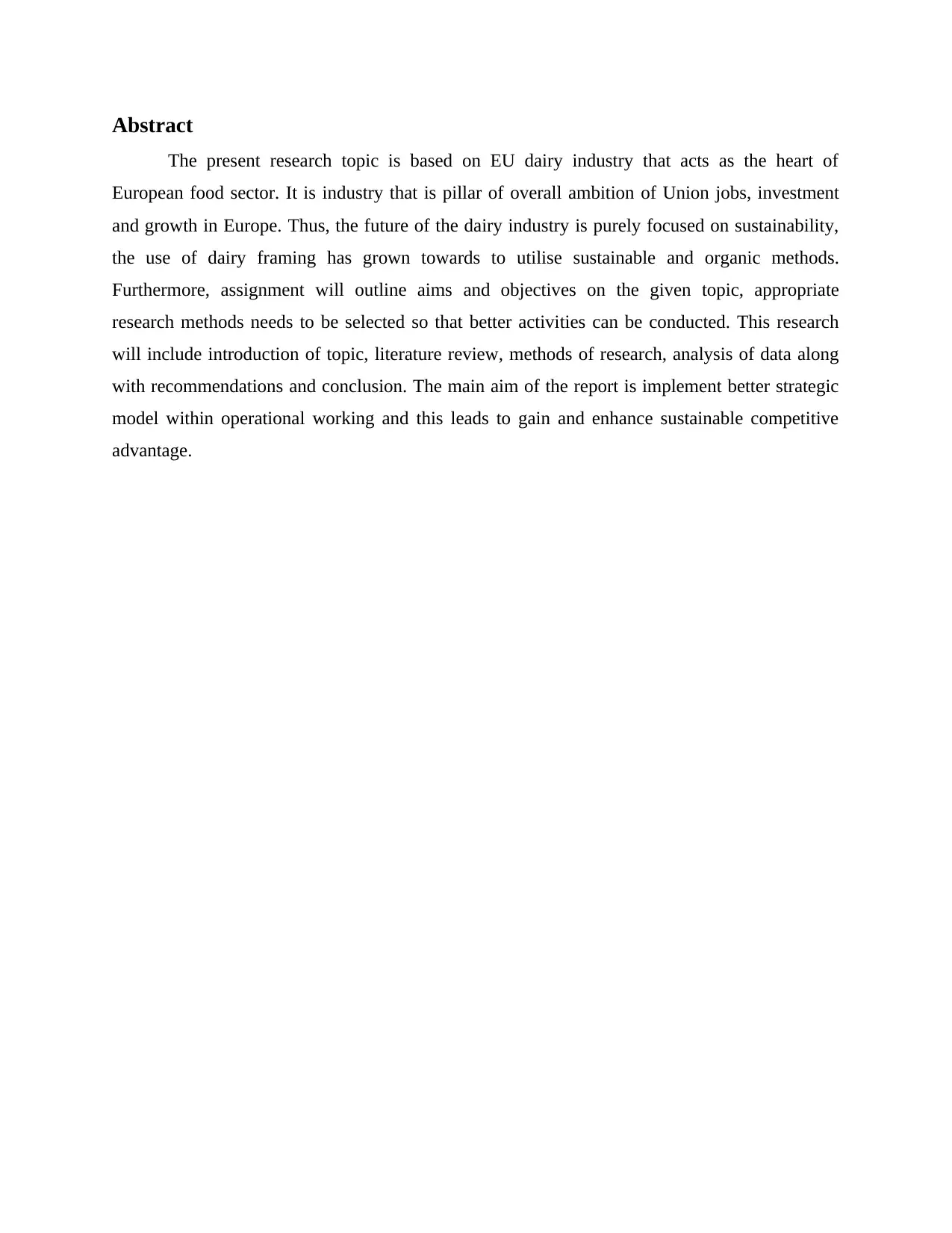
Abstract
The present research topic is based on EU dairy industry that acts as the heart of
European food sector. It is industry that is pillar of overall ambition of Union jobs, investment
and growth in Europe. Thus, the future of the dairy industry is purely focused on sustainability,
the use of dairy framing has grown towards to utilise sustainable and organic methods.
Furthermore, assignment will outline aims and objectives on the given topic, appropriate
research methods needs to be selected so that better activities can be conducted. This research
will include introduction of topic, literature review, methods of research, analysis of data along
with recommendations and conclusion. The main aim of the report is implement better strategic
model within operational working and this leads to gain and enhance sustainable competitive
advantage.
The present research topic is based on EU dairy industry that acts as the heart of
European food sector. It is industry that is pillar of overall ambition of Union jobs, investment
and growth in Europe. Thus, the future of the dairy industry is purely focused on sustainability,
the use of dairy framing has grown towards to utilise sustainable and organic methods.
Furthermore, assignment will outline aims and objectives on the given topic, appropriate
research methods needs to be selected so that better activities can be conducted. This research
will include introduction of topic, literature review, methods of research, analysis of data along
with recommendations and conclusion. The main aim of the report is implement better strategic
model within operational working and this leads to gain and enhance sustainable competitive
advantage.
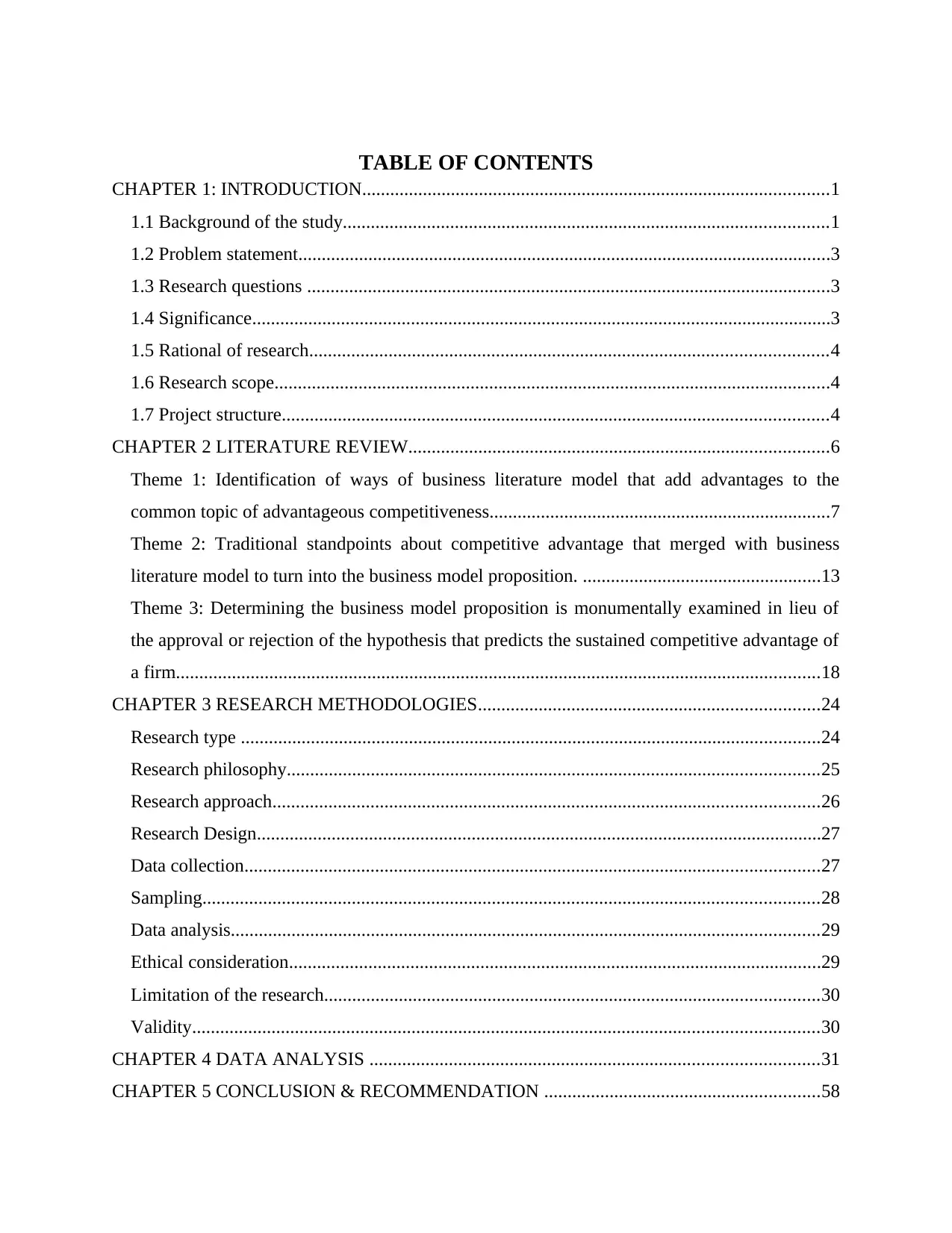
TABLE OF CONTENTS
CHAPTER 1: INTRODUCTION....................................................................................................1
1.1 Background of the study........................................................................................................1
1.2 Problem statement..................................................................................................................3
1.3 Research questions ................................................................................................................3
1.4 Significance............................................................................................................................3
1.5 Rational of research...............................................................................................................4
1.6 Research scope.......................................................................................................................4
1.7 Project structure.....................................................................................................................4
CHAPTER 2 LITERATURE REVIEW..........................................................................................6
Theme 1: Identification of ways of business literature model that add advantages to the
common topic of advantageous competitiveness.........................................................................7
Theme 2: Traditional standpoints about competitive advantage that merged with business
literature model to turn into the business model proposition. ...................................................13
Theme 3: Determining the business model proposition is monumentally examined in lieu of
the approval or rejection of the hypothesis that predicts the sustained competitive advantage of
a firm..........................................................................................................................................18
CHAPTER 3 RESEARCH METHODOLOGIES.........................................................................24
Research type ............................................................................................................................24
Research philosophy..................................................................................................................25
Research approach.....................................................................................................................26
Research Design.........................................................................................................................27
Data collection...........................................................................................................................27
Sampling....................................................................................................................................28
Data analysis..............................................................................................................................29
Ethical consideration..................................................................................................................29
Limitation of the research..........................................................................................................30
Validity......................................................................................................................................30
CHAPTER 4 DATA ANALYSIS ................................................................................................31
CHAPTER 5 CONCLUSION & RECOMMENDATION ...........................................................58
CHAPTER 1: INTRODUCTION....................................................................................................1
1.1 Background of the study........................................................................................................1
1.2 Problem statement..................................................................................................................3
1.3 Research questions ................................................................................................................3
1.4 Significance............................................................................................................................3
1.5 Rational of research...............................................................................................................4
1.6 Research scope.......................................................................................................................4
1.7 Project structure.....................................................................................................................4
CHAPTER 2 LITERATURE REVIEW..........................................................................................6
Theme 1: Identification of ways of business literature model that add advantages to the
common topic of advantageous competitiveness.........................................................................7
Theme 2: Traditional standpoints about competitive advantage that merged with business
literature model to turn into the business model proposition. ...................................................13
Theme 3: Determining the business model proposition is monumentally examined in lieu of
the approval or rejection of the hypothesis that predicts the sustained competitive advantage of
a firm..........................................................................................................................................18
CHAPTER 3 RESEARCH METHODOLOGIES.........................................................................24
Research type ............................................................................................................................24
Research philosophy..................................................................................................................25
Research approach.....................................................................................................................26
Research Design.........................................................................................................................27
Data collection...........................................................................................................................27
Sampling....................................................................................................................................28
Data analysis..............................................................................................................................29
Ethical consideration..................................................................................................................29
Limitation of the research..........................................................................................................30
Validity......................................................................................................................................30
CHAPTER 4 DATA ANALYSIS ................................................................................................31
CHAPTER 5 CONCLUSION & RECOMMENDATION ...........................................................58
⊘ This is a preview!⊘
Do you want full access?
Subscribe today to unlock all pages.

Trusted by 1+ million students worldwide

Conclusion.................................................................................................................................58
Recommendation.......................................................................................................................58
REFERENCES..............................................................................................................................60
APPENDIX....................................................................................................................................63
Recommendation.......................................................................................................................58
REFERENCES..............................................................................................................................60
APPENDIX....................................................................................................................................63
Paraphrase This Document
Need a fresh take? Get an instant paraphrase of this document with our AI Paraphraser
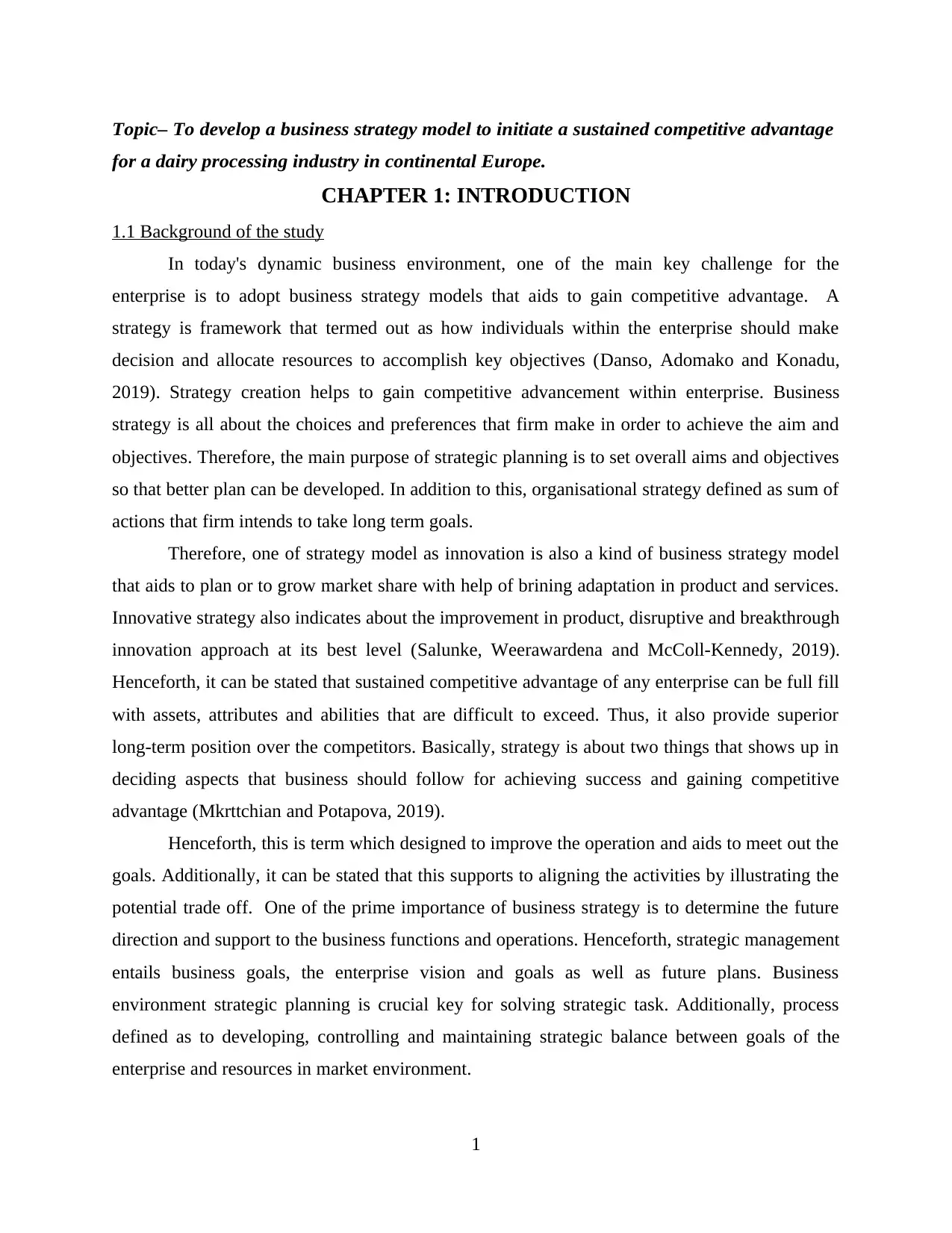
Topic– To develop a business strategy model to initiate a sustained competitive advantage
for a dairy processing industry in continental Europe.
CHAPTER 1: INTRODUCTION
1.1 Background of the study
In today's dynamic business environment, one of the main key challenge for the
enterprise is to adopt business strategy models that aids to gain competitive advantage. A
strategy is framework that termed out as how individuals within the enterprise should make
decision and allocate resources to accomplish key objectives (Danso, Adomako and Konadu,
2019). Strategy creation helps to gain competitive advancement within enterprise. Business
strategy is all about the choices and preferences that firm make in order to achieve the aim and
objectives. Therefore, the main purpose of strategic planning is to set overall aims and objectives
so that better plan can be developed. In addition to this, organisational strategy defined as sum of
actions that firm intends to take long term goals.
Therefore, one of strategy model as innovation is also a kind of business strategy model
that aids to plan or to grow market share with help of brining adaptation in product and services.
Innovative strategy also indicates about the improvement in product, disruptive and breakthrough
innovation approach at its best level (Salunke, Weerawardena and McColl-Kennedy, 2019).
Henceforth, it can be stated that sustained competitive advantage of any enterprise can be full fill
with assets, attributes and abilities that are difficult to exceed. Thus, it also provide superior
long-term position over the competitors. Basically, strategy is about two things that shows up in
deciding aspects that business should follow for achieving success and gaining competitive
advantage (Mkrttchian and Potapova, 2019).
Henceforth, this is term which designed to improve the operation and aids to meet out the
goals. Additionally, it can be stated that this supports to aligning the activities by illustrating the
potential trade off. One of the prime importance of business strategy is to determine the future
direction and support to the business functions and operations. Henceforth, strategic management
entails business goals, the enterprise vision and goals as well as future plans. Business
environment strategic planning is crucial key for solving strategic task. Additionally, process
defined as to developing, controlling and maintaining strategic balance between goals of the
enterprise and resources in market environment.
1
for a dairy processing industry in continental Europe.
CHAPTER 1: INTRODUCTION
1.1 Background of the study
In today's dynamic business environment, one of the main key challenge for the
enterprise is to adopt business strategy models that aids to gain competitive advantage. A
strategy is framework that termed out as how individuals within the enterprise should make
decision and allocate resources to accomplish key objectives (Danso, Adomako and Konadu,
2019). Strategy creation helps to gain competitive advancement within enterprise. Business
strategy is all about the choices and preferences that firm make in order to achieve the aim and
objectives. Therefore, the main purpose of strategic planning is to set overall aims and objectives
so that better plan can be developed. In addition to this, organisational strategy defined as sum of
actions that firm intends to take long term goals.
Therefore, one of strategy model as innovation is also a kind of business strategy model
that aids to plan or to grow market share with help of brining adaptation in product and services.
Innovative strategy also indicates about the improvement in product, disruptive and breakthrough
innovation approach at its best level (Salunke, Weerawardena and McColl-Kennedy, 2019).
Henceforth, it can be stated that sustained competitive advantage of any enterprise can be full fill
with assets, attributes and abilities that are difficult to exceed. Thus, it also provide superior
long-term position over the competitors. Basically, strategy is about two things that shows up in
deciding aspects that business should follow for achieving success and gaining competitive
advantage (Mkrttchian and Potapova, 2019).
Henceforth, this is term which designed to improve the operation and aids to meet out the
goals. Additionally, it can be stated that this supports to aligning the activities by illustrating the
potential trade off. One of the prime importance of business strategy is to determine the future
direction and support to the business functions and operations. Henceforth, strategic management
entails business goals, the enterprise vision and goals as well as future plans. Business
environment strategic planning is crucial key for solving strategic task. Additionally, process
defined as to developing, controlling and maintaining strategic balance between goals of the
enterprise and resources in market environment.
1
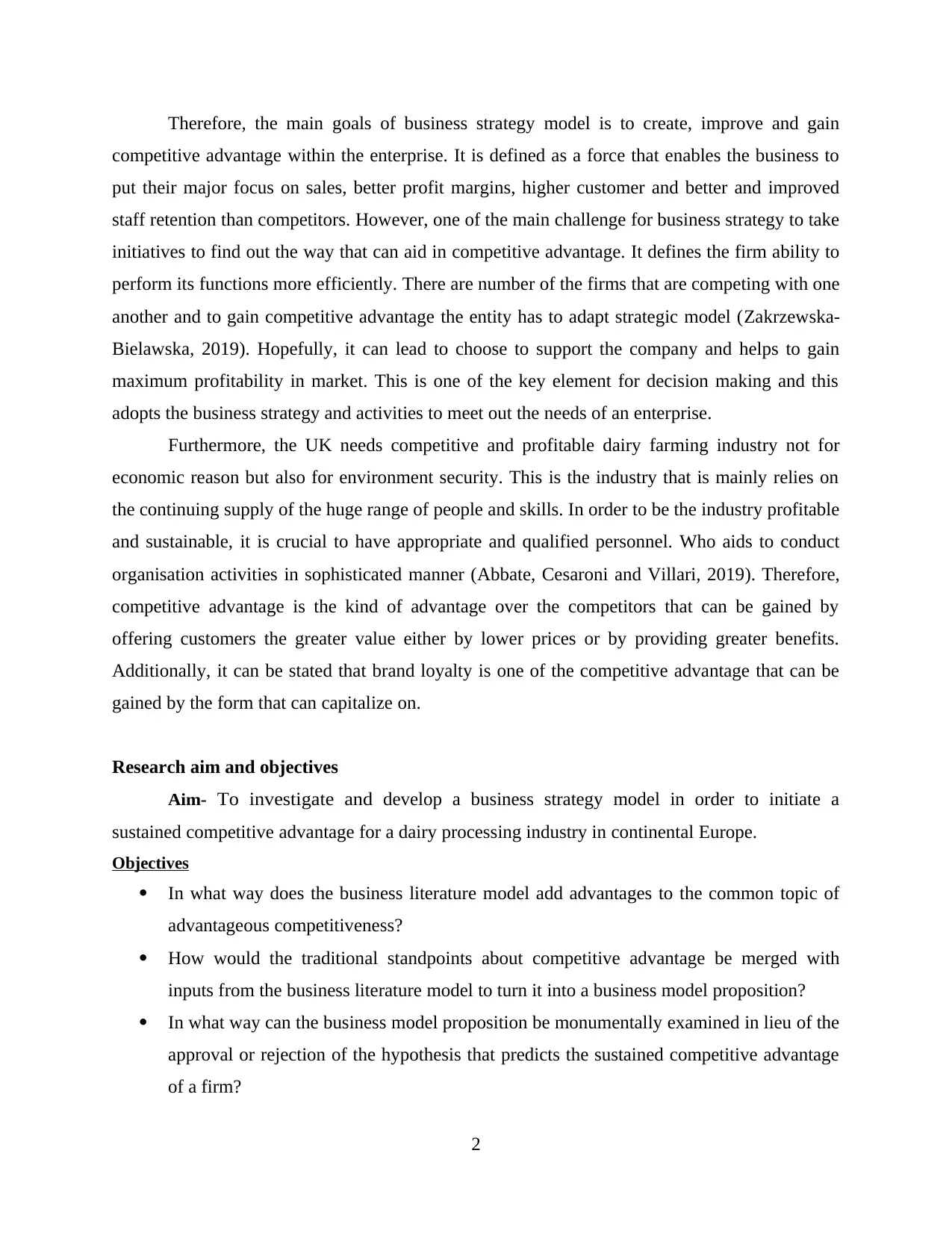
Therefore, the main goals of business strategy model is to create, improve and gain
competitive advantage within the enterprise. It is defined as a force that enables the business to
put their major focus on sales, better profit margins, higher customer and better and improved
staff retention than competitors. However, one of the main challenge for business strategy to take
initiatives to find out the way that can aid in competitive advantage. It defines the firm ability to
perform its functions more efficiently. There are number of the firms that are competing with one
another and to gain competitive advantage the entity has to adapt strategic model (Zakrzewska-
Bielawska, 2019). Hopefully, it can lead to choose to support the company and helps to gain
maximum profitability in market. This is one of the key element for decision making and this
adopts the business strategy and activities to meet out the needs of an enterprise.
Furthermore, the UK needs competitive and profitable dairy farming industry not for
economic reason but also for environment security. This is the industry that is mainly relies on
the continuing supply of the huge range of people and skills. In order to be the industry profitable
and sustainable, it is crucial to have appropriate and qualified personnel. Who aids to conduct
organisation activities in sophisticated manner (Abbate, Cesaroni and Villari, 2019). Therefore,
competitive advantage is the kind of advantage over the competitors that can be gained by
offering customers the greater value either by lower prices or by providing greater benefits.
Additionally, it can be stated that brand loyalty is one of the competitive advantage that can be
gained by the form that can capitalize on.
Research aim and objectives
Aim- To investigate and develop a business strategy model in order to initiate a
sustained competitive advantage for a dairy processing industry in continental Europe.
Objectives
In what way does the business literature model add advantages to the common topic of
advantageous competitiveness?
How would the traditional standpoints about competitive advantage be merged with
inputs from the business literature model to turn it into a business model proposition?
In what way can the business model proposition be monumentally examined in lieu of the
approval or rejection of the hypothesis that predicts the sustained competitive advantage
of a firm?
2
competitive advantage within the enterprise. It is defined as a force that enables the business to
put their major focus on sales, better profit margins, higher customer and better and improved
staff retention than competitors. However, one of the main challenge for business strategy to take
initiatives to find out the way that can aid in competitive advantage. It defines the firm ability to
perform its functions more efficiently. There are number of the firms that are competing with one
another and to gain competitive advantage the entity has to adapt strategic model (Zakrzewska-
Bielawska, 2019). Hopefully, it can lead to choose to support the company and helps to gain
maximum profitability in market. This is one of the key element for decision making and this
adopts the business strategy and activities to meet out the needs of an enterprise.
Furthermore, the UK needs competitive and profitable dairy farming industry not for
economic reason but also for environment security. This is the industry that is mainly relies on
the continuing supply of the huge range of people and skills. In order to be the industry profitable
and sustainable, it is crucial to have appropriate and qualified personnel. Who aids to conduct
organisation activities in sophisticated manner (Abbate, Cesaroni and Villari, 2019). Therefore,
competitive advantage is the kind of advantage over the competitors that can be gained by
offering customers the greater value either by lower prices or by providing greater benefits.
Additionally, it can be stated that brand loyalty is one of the competitive advantage that can be
gained by the form that can capitalize on.
Research aim and objectives
Aim- To investigate and develop a business strategy model in order to initiate a
sustained competitive advantage for a dairy processing industry in continental Europe.
Objectives
In what way does the business literature model add advantages to the common topic of
advantageous competitiveness?
How would the traditional standpoints about competitive advantage be merged with
inputs from the business literature model to turn it into a business model proposition?
In what way can the business model proposition be monumentally examined in lieu of the
approval or rejection of the hypothesis that predicts the sustained competitive advantage
of a firm?
2
⊘ This is a preview!⊘
Do you want full access?
Subscribe today to unlock all pages.

Trusted by 1+ million students worldwide
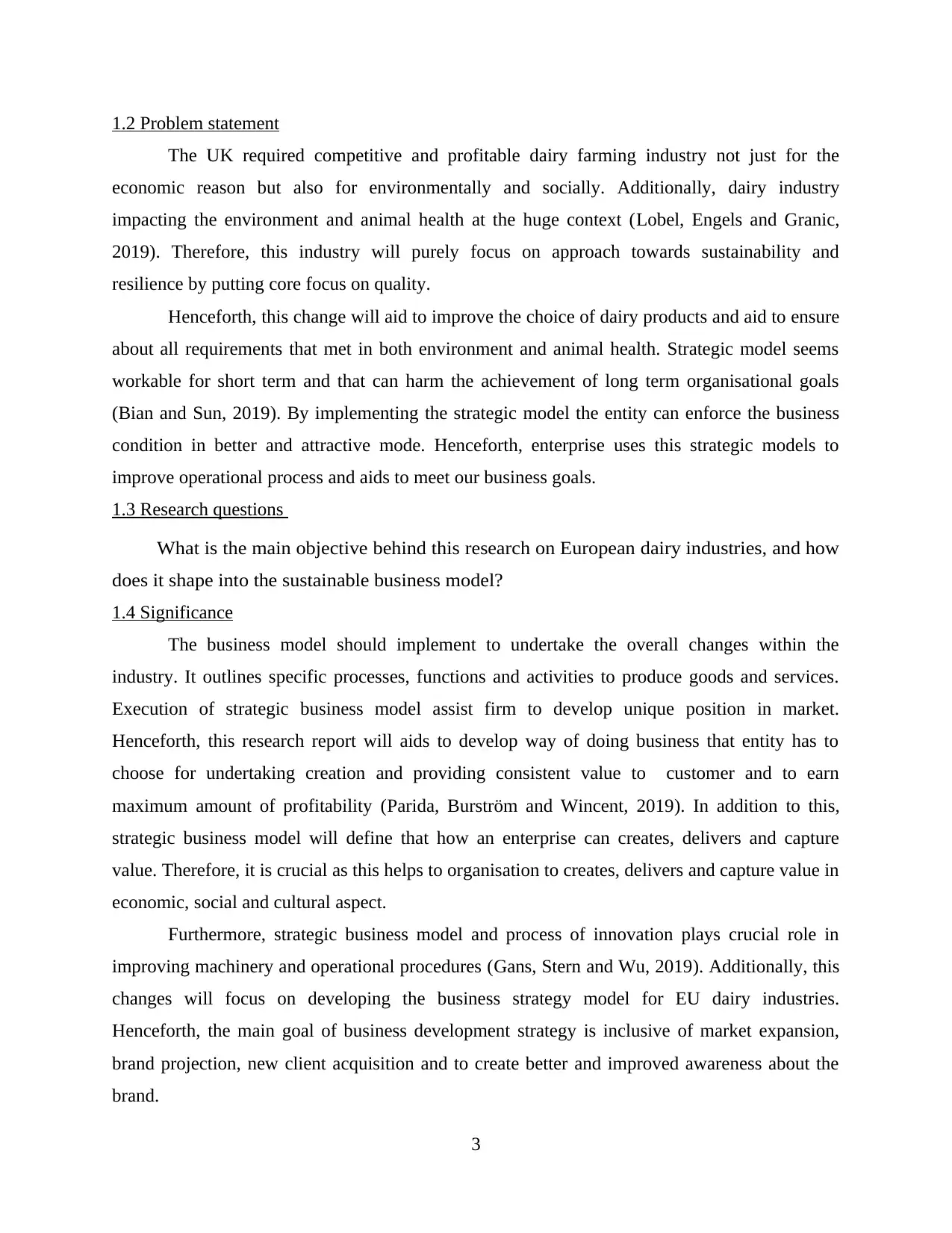
1.2 Problem statement
The UK required competitive and profitable dairy farming industry not just for the
economic reason but also for environmentally and socially. Additionally, dairy industry
impacting the environment and animal health at the huge context (Lobel, Engels and Granic,
2019). Therefore, this industry will purely focus on approach towards sustainability and
resilience by putting core focus on quality.
Henceforth, this change will aid to improve the choice of dairy products and aid to ensure
about all requirements that met in both environment and animal health. Strategic model seems
workable for short term and that can harm the achievement of long term organisational goals
(Bian and Sun, 2019). By implementing the strategic model the entity can enforce the business
condition in better and attractive mode. Henceforth, enterprise uses this strategic models to
improve operational process and aids to meet our business goals.
1.3 Research questions
What is the main objective behind this research on European dairy industries, and how
does it shape into the sustainable business model?
1.4 Significance
The business model should implement to undertake the overall changes within the
industry. It outlines specific processes, functions and activities to produce goods and services.
Execution of strategic business model assist firm to develop unique position in market.
Henceforth, this research report will aids to develop way of doing business that entity has to
choose for undertaking creation and providing consistent value to customer and to earn
maximum amount of profitability (Parida, Burström and Wincent, 2019). In addition to this,
strategic business model will define that how an enterprise can creates, delivers and capture
value. Therefore, it is crucial as this helps to organisation to creates, delivers and capture value in
economic, social and cultural aspect.
Furthermore, strategic business model and process of innovation plays crucial role in
improving machinery and operational procedures (Gans, Stern and Wu, 2019). Additionally, this
changes will focus on developing the business strategy model for EU dairy industries.
Henceforth, the main goal of business development strategy is inclusive of market expansion,
brand projection, new client acquisition and to create better and improved awareness about the
brand.
3
The UK required competitive and profitable dairy farming industry not just for the
economic reason but also for environmentally and socially. Additionally, dairy industry
impacting the environment and animal health at the huge context (Lobel, Engels and Granic,
2019). Therefore, this industry will purely focus on approach towards sustainability and
resilience by putting core focus on quality.
Henceforth, this change will aid to improve the choice of dairy products and aid to ensure
about all requirements that met in both environment and animal health. Strategic model seems
workable for short term and that can harm the achievement of long term organisational goals
(Bian and Sun, 2019). By implementing the strategic model the entity can enforce the business
condition in better and attractive mode. Henceforth, enterprise uses this strategic models to
improve operational process and aids to meet our business goals.
1.3 Research questions
What is the main objective behind this research on European dairy industries, and how
does it shape into the sustainable business model?
1.4 Significance
The business model should implement to undertake the overall changes within the
industry. It outlines specific processes, functions and activities to produce goods and services.
Execution of strategic business model assist firm to develop unique position in market.
Henceforth, this research report will aids to develop way of doing business that entity has to
choose for undertaking creation and providing consistent value to customer and to earn
maximum amount of profitability (Parida, Burström and Wincent, 2019). In addition to this,
strategic business model will define that how an enterprise can creates, delivers and capture
value. Therefore, it is crucial as this helps to organisation to creates, delivers and capture value in
economic, social and cultural aspect.
Furthermore, strategic business model and process of innovation plays crucial role in
improving machinery and operational procedures (Gans, Stern and Wu, 2019). Additionally, this
changes will focus on developing the business strategy model for EU dairy industries.
Henceforth, the main goal of business development strategy is inclusive of market expansion,
brand projection, new client acquisition and to create better and improved awareness about the
brand.
3
Paraphrase This Document
Need a fresh take? Get an instant paraphrase of this document with our AI Paraphraser

Therefore, one of the beneficial aspect of strategic management is to become more
disciplined and organized. This will help the researcher to bridges the link between performance
and rewards for employees. Additionally, this research will help the researcher to gain the depth
insights about the uses and effect of strategic model to gain sustainable competitive advantage.
1.5 Rational of research
In the changing scenario of the business enterprise, advanced innovation and strategic
business model aids to bring competitive advancement and unique position to enterprise. In the
market the most of the enterprise is using technological innovation so that better and improved
services can be delivered (Bustinza, Gomes and Baines, 2019). Sustainability and resilience are
two core components that aids to bring better advancement to enterprise. This report will aids to
expand the knowledge of the researcher about the uses of strategic models and their benefits that
leads to gain sustainable competitive advancement within market.
Additionally, development within the industry with the help of strategic business model
makes the whole system effective and this leads to accomplish unique advancement (Singh and
El-Kassar, 2019). Henceforth, this report will put major focus over developing the business
strategy model for EU dairy industries specifically.
1.6 Research scope
This research will mainly define the overall strategy to implement strategic business
models as Porter five forces, Business canvas model etc. Additionally, it aids to identify the
current trends, usage, supplier’s activities and behaviour of the customer within the market.
Therefore, it will be conducted in terms to initiate sustained competitive advantage for the dairy
processing industry in continental Europe (Sahaf, 2019).
To enhance the competitive advantage of the business, the above given model will work
as to guiding tool that can aids to improve competitive advantage (Ferreira, Coelho and
Weersma, 2019).
1.7 Project structure
This is term that defines the overall structure of research project and includes different
chapters. Therefore, it’s all discussed in systematic manner to understand the each chapter in
proper mode. Thus, the project team is the structure that facilitates the coordination and
implementation of project activities. Henceforth, structure of the project defined in the following
manner as are-
4
disciplined and organized. This will help the researcher to bridges the link between performance
and rewards for employees. Additionally, this research will help the researcher to gain the depth
insights about the uses and effect of strategic model to gain sustainable competitive advantage.
1.5 Rational of research
In the changing scenario of the business enterprise, advanced innovation and strategic
business model aids to bring competitive advancement and unique position to enterprise. In the
market the most of the enterprise is using technological innovation so that better and improved
services can be delivered (Bustinza, Gomes and Baines, 2019). Sustainability and resilience are
two core components that aids to bring better advancement to enterprise. This report will aids to
expand the knowledge of the researcher about the uses of strategic models and their benefits that
leads to gain sustainable competitive advancement within market.
Additionally, development within the industry with the help of strategic business model
makes the whole system effective and this leads to accomplish unique advancement (Singh and
El-Kassar, 2019). Henceforth, this report will put major focus over developing the business
strategy model for EU dairy industries specifically.
1.6 Research scope
This research will mainly define the overall strategy to implement strategic business
models as Porter five forces, Business canvas model etc. Additionally, it aids to identify the
current trends, usage, supplier’s activities and behaviour of the customer within the market.
Therefore, it will be conducted in terms to initiate sustained competitive advantage for the dairy
processing industry in continental Europe (Sahaf, 2019).
To enhance the competitive advantage of the business, the above given model will work
as to guiding tool that can aids to improve competitive advantage (Ferreira, Coelho and
Weersma, 2019).
1.7 Project structure
This is term that defines the overall structure of research project and includes different
chapters. Therefore, it’s all discussed in systematic manner to understand the each chapter in
proper mode. Thus, the project team is the structure that facilitates the coordination and
implementation of project activities. Henceforth, structure of the project defined in the following
manner as are-
4

Chapter 1 Introduction- It is the first chapter that will provide an overview of research
topic. Additionally, researcher will define background, objectives, aims, research questions etc.
that needs to achieve. Therefore, it is the initial part of the research that aids to carry out the
whole research in the systematic manner.
Chapter 2 Literature review- This is the second chapter that aids to analyse the
secondary data information and that can be collect with the journal articles, book etc. It is term
that aids to gather the depth description about the topic of research. Therefore, secondary data
can be collected and analysed that can make it easy for the user to know about the subject so that
depth information about the topic can be ascertained. With the help of this, the depth information
to the research can be gathered.
Chapter 3 Research Methodologies- It is the chapter that aids to define the depth
information about differ types of research methods. This is helpful in order to adopt the specific
method to collect the whole data in specific manner. Therefore, this is systematic method that
provide an overview about the whole research so that better information can be conducted.
Herein, this term is defined as systematic plan for doing research and also inclusive of method as
data collection, interpretation, implication etc. With help of selecting proper method to research,
the researcher can determine the information in reliable mode.
Chapter 4 Data analysis- This is defined as procedures that aids to provide systematic
information. By application of statistical and logical technique to define, illustrate and evaluate
the data effectively (Li and McMillan, 2019). Henceforth, this chapter will show that how
primary data will be interpreted and collected. Thus, it is inclusive of graph, chart, table etc.
Additionally, it aids to do the project along with the interpretation to gather reliable data.
Chapter 5 Discussion and analysis- Under this, result and analysis will be discussed and
that will show findings of the overall research activities. Therefore, researcher can able to give
an in-depth analysis of the data and information. It can be collected with the primary method. It
will make it easier for the user to evaluate and identify the overall findings of the project. It is the
section that aids to analyse the whole findings in depth mode.
Chapter 6: Conclusion- It is the last chapter in which conclusion can be done effectively.
Herein, the researcher shows that what can be concluded after completing the project. It is the
chapter that provides an insight which is helpful to collect the findings and information as per the
data.
5
topic. Additionally, researcher will define background, objectives, aims, research questions etc.
that needs to achieve. Therefore, it is the initial part of the research that aids to carry out the
whole research in the systematic manner.
Chapter 2 Literature review- This is the second chapter that aids to analyse the
secondary data information and that can be collect with the journal articles, book etc. It is term
that aids to gather the depth description about the topic of research. Therefore, secondary data
can be collected and analysed that can make it easy for the user to know about the subject so that
depth information about the topic can be ascertained. With the help of this, the depth information
to the research can be gathered.
Chapter 3 Research Methodologies- It is the chapter that aids to define the depth
information about differ types of research methods. This is helpful in order to adopt the specific
method to collect the whole data in specific manner. Therefore, this is systematic method that
provide an overview about the whole research so that better information can be conducted.
Herein, this term is defined as systematic plan for doing research and also inclusive of method as
data collection, interpretation, implication etc. With help of selecting proper method to research,
the researcher can determine the information in reliable mode.
Chapter 4 Data analysis- This is defined as procedures that aids to provide systematic
information. By application of statistical and logical technique to define, illustrate and evaluate
the data effectively (Li and McMillan, 2019). Henceforth, this chapter will show that how
primary data will be interpreted and collected. Thus, it is inclusive of graph, chart, table etc.
Additionally, it aids to do the project along with the interpretation to gather reliable data.
Chapter 5 Discussion and analysis- Under this, result and analysis will be discussed and
that will show findings of the overall research activities. Therefore, researcher can able to give
an in-depth analysis of the data and information. It can be collected with the primary method. It
will make it easier for the user to evaluate and identify the overall findings of the project. It is the
section that aids to analyse the whole findings in depth mode.
Chapter 6: Conclusion- It is the last chapter in which conclusion can be done effectively.
Herein, the researcher shows that what can be concluded after completing the project. It is the
chapter that provides an insight which is helpful to collect the findings and information as per the
data.
5
⊘ This is a preview!⊘
Do you want full access?
Subscribe today to unlock all pages.

Trusted by 1+ million students worldwide
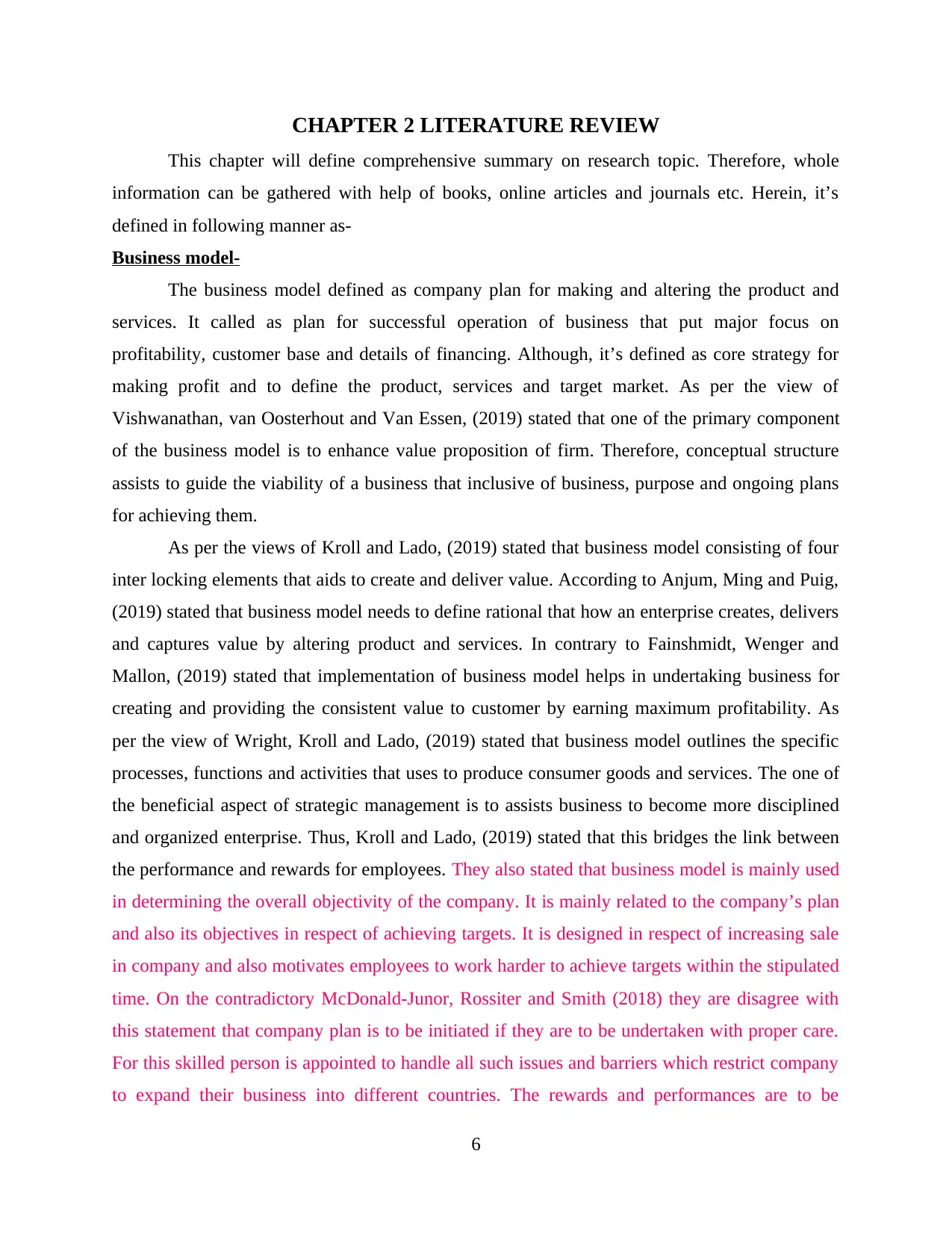
CHAPTER 2 LITERATURE REVIEW
This chapter will define comprehensive summary on research topic. Therefore, whole
information can be gathered with help of books, online articles and journals etc. Herein, it’s
defined in following manner as-
Business model-
The business model defined as company plan for making and altering the product and
services. It called as plan for successful operation of business that put major focus on
profitability, customer base and details of financing. Although, it’s defined as core strategy for
making profit and to define the product, services and target market. As per the view of
Vishwanathan, van Oosterhout and Van Essen, (2019) stated that one of the primary component
of the business model is to enhance value proposition of firm. Therefore, conceptual structure
assists to guide the viability of a business that inclusive of business, purpose and ongoing plans
for achieving them.
As per the views of Kroll and Lado, (2019) stated that business model consisting of four
inter locking elements that aids to create and deliver value. According to Anjum, Ming and Puig,
(2019) stated that business model needs to define rational that how an enterprise creates, delivers
and captures value by altering product and services. In contrary to Fainshmidt, Wenger and
Mallon, (2019) stated that implementation of business model helps in undertaking business for
creating and providing the consistent value to customer by earning maximum profitability. As
per the view of Wright, Kroll and Lado, (2019) stated that business model outlines the specific
processes, functions and activities that uses to produce consumer goods and services. The one of
the beneficial aspect of strategic management is to assists business to become more disciplined
and organized enterprise. Thus, Kroll and Lado, (2019) stated that this bridges the link between
the performance and rewards for employees. They also stated that business model is mainly used
in determining the overall objectivity of the company. It is mainly related to the company’s plan
and also its objectives in respect of achieving targets. It is designed in respect of increasing sale
in company and also motivates employees to work harder to achieve targets within the stipulated
time. On the contradictory McDonald-Junor, Rossiter and Smith (2018) they are disagree with
this statement that company plan is to be initiated if they are to be undertaken with proper care.
For this skilled person is appointed to handle all such issues and barriers which restrict company
to expand their business into different countries. The rewards and performances are to be
6
This chapter will define comprehensive summary on research topic. Therefore, whole
information can be gathered with help of books, online articles and journals etc. Herein, it’s
defined in following manner as-
Business model-
The business model defined as company plan for making and altering the product and
services. It called as plan for successful operation of business that put major focus on
profitability, customer base and details of financing. Although, it’s defined as core strategy for
making profit and to define the product, services and target market. As per the view of
Vishwanathan, van Oosterhout and Van Essen, (2019) stated that one of the primary component
of the business model is to enhance value proposition of firm. Therefore, conceptual structure
assists to guide the viability of a business that inclusive of business, purpose and ongoing plans
for achieving them.
As per the views of Kroll and Lado, (2019) stated that business model consisting of four
inter locking elements that aids to create and deliver value. According to Anjum, Ming and Puig,
(2019) stated that business model needs to define rational that how an enterprise creates, delivers
and captures value by altering product and services. In contrary to Fainshmidt, Wenger and
Mallon, (2019) stated that implementation of business model helps in undertaking business for
creating and providing the consistent value to customer by earning maximum profitability. As
per the view of Wright, Kroll and Lado, (2019) stated that business model outlines the specific
processes, functions and activities that uses to produce consumer goods and services. The one of
the beneficial aspect of strategic management is to assists business to become more disciplined
and organized enterprise. Thus, Kroll and Lado, (2019) stated that this bridges the link between
the performance and rewards for employees. They also stated that business model is mainly used
in determining the overall objectivity of the company. It is mainly related to the company’s plan
and also its objectives in respect of achieving targets. It is designed in respect of increasing sale
in company and also motivates employees to work harder to achieve targets within the stipulated
time. On the contradictory McDonald-Junor, Rossiter and Smith (2018) they are disagree with
this statement that company plan is to be initiated if they are to be undertaken with proper care.
For this skilled person is appointed to handle all such issues and barriers which restrict company
to expand their business into different countries. The rewards and performances are to be
6
Paraphrase This Document
Need a fresh take? Get an instant paraphrase of this document with our AI Paraphraser
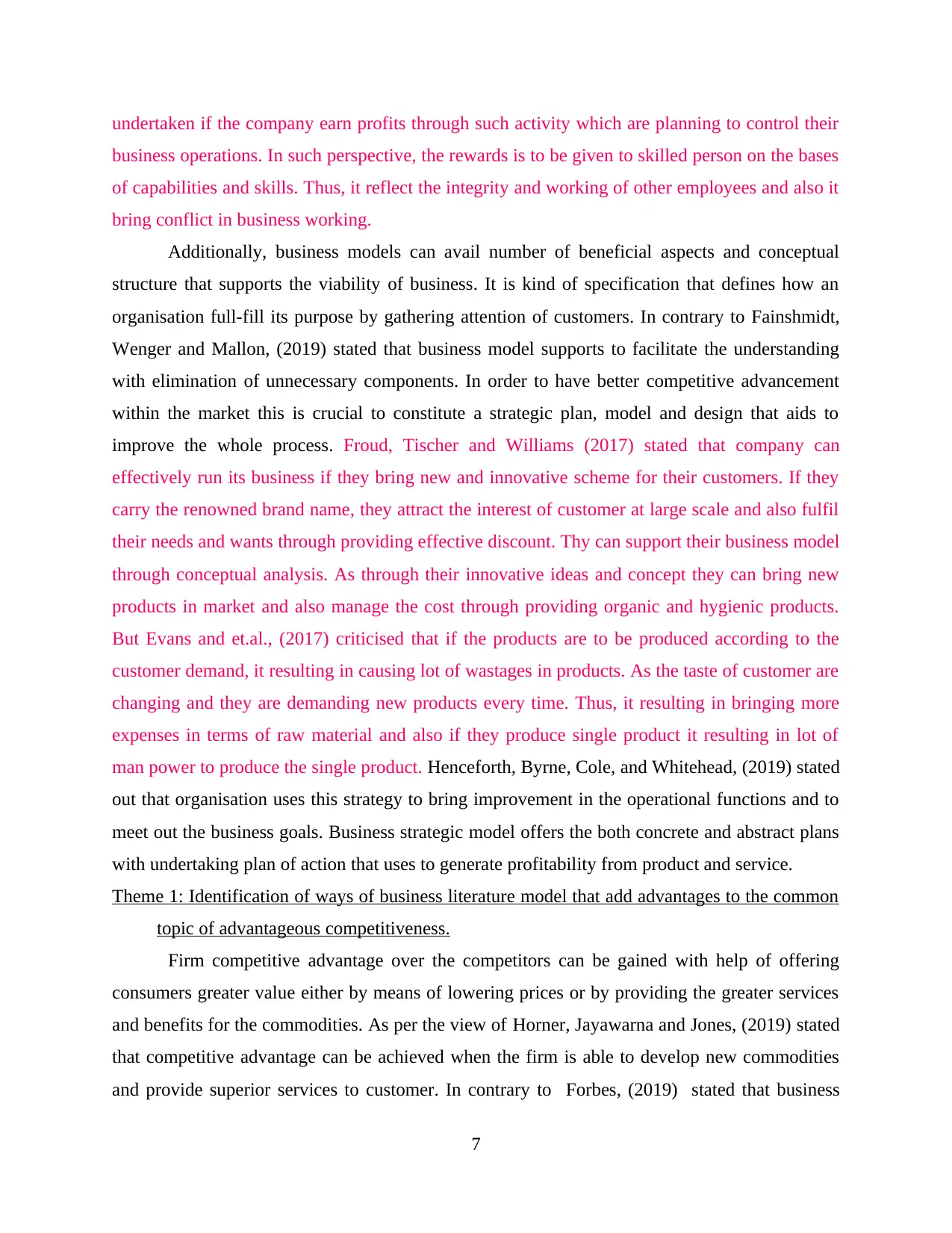
undertaken if the company earn profits through such activity which are planning to control their
business operations. In such perspective, the rewards is to be given to skilled person on the bases
of capabilities and skills. Thus, it reflect the integrity and working of other employees and also it
bring conflict in business working.
Additionally, business models can avail number of beneficial aspects and conceptual
structure that supports the viability of business. It is kind of specification that defines how an
organisation full-fill its purpose by gathering attention of customers. In contrary to Fainshmidt,
Wenger and Mallon, (2019) stated that business model supports to facilitate the understanding
with elimination of unnecessary components. In order to have better competitive advancement
within the market this is crucial to constitute a strategic plan, model and design that aids to
improve the whole process. Froud, Tischer and Williams (2017) stated that company can
effectively run its business if they bring new and innovative scheme for their customers. If they
carry the renowned brand name, they attract the interest of customer at large scale and also fulfil
their needs and wants through providing effective discount. Thy can support their business model
through conceptual analysis. As through their innovative ideas and concept they can bring new
products in market and also manage the cost through providing organic and hygienic products.
But Evans and et.al., (2017) criticised that if the products are to be produced according to the
customer demand, it resulting in causing lot of wastages in products. As the taste of customer are
changing and they are demanding new products every time. Thus, it resulting in bringing more
expenses in terms of raw material and also if they produce single product it resulting in lot of
man power to produce the single product. Henceforth, Byrne, Cole, and Whitehead, (2019) stated
out that organisation uses this strategy to bring improvement in the operational functions and to
meet out the business goals. Business strategic model offers the both concrete and abstract plans
with undertaking plan of action that uses to generate profitability from product and service.
Theme 1: Identification of ways of business literature model that add advantages to the common
topic of advantageous competitiveness.
Firm competitive advantage over the competitors can be gained with help of offering
consumers greater value either by means of lowering prices or by providing the greater services
and benefits for the commodities. As per the view of Horner, Jayawarna and Jones, (2019) stated
that competitive advantage can be achieved when the firm is able to develop new commodities
and provide superior services to customer. In contrary to Forbes, (2019) stated that business
7
business operations. In such perspective, the rewards is to be given to skilled person on the bases
of capabilities and skills. Thus, it reflect the integrity and working of other employees and also it
bring conflict in business working.
Additionally, business models can avail number of beneficial aspects and conceptual
structure that supports the viability of business. It is kind of specification that defines how an
organisation full-fill its purpose by gathering attention of customers. In contrary to Fainshmidt,
Wenger and Mallon, (2019) stated that business model supports to facilitate the understanding
with elimination of unnecessary components. In order to have better competitive advancement
within the market this is crucial to constitute a strategic plan, model and design that aids to
improve the whole process. Froud, Tischer and Williams (2017) stated that company can
effectively run its business if they bring new and innovative scheme for their customers. If they
carry the renowned brand name, they attract the interest of customer at large scale and also fulfil
their needs and wants through providing effective discount. Thy can support their business model
through conceptual analysis. As through their innovative ideas and concept they can bring new
products in market and also manage the cost through providing organic and hygienic products.
But Evans and et.al., (2017) criticised that if the products are to be produced according to the
customer demand, it resulting in causing lot of wastages in products. As the taste of customer are
changing and they are demanding new products every time. Thus, it resulting in bringing more
expenses in terms of raw material and also if they produce single product it resulting in lot of
man power to produce the single product. Henceforth, Byrne, Cole, and Whitehead, (2019) stated
out that organisation uses this strategy to bring improvement in the operational functions and to
meet out the business goals. Business strategic model offers the both concrete and abstract plans
with undertaking plan of action that uses to generate profitability from product and service.
Theme 1: Identification of ways of business literature model that add advantages to the common
topic of advantageous competitiveness.
Firm competitive advantage over the competitors can be gained with help of offering
consumers greater value either by means of lowering prices or by providing the greater services
and benefits for the commodities. As per the view of Horner, Jayawarna and Jones, (2019) stated
that competitive advantage can be achieved when the firm is able to develop new commodities
and provide superior services to customer. In contrary to Forbes, (2019) stated that business
7

defined as human activity in competitive market setting and that can be characterized with help
of exchange of good and services for money. In contrary to Hartman, Parra and de Roo, (2019)
stated that one of the key element of using business model in enterprise is to build competitive
advantage in market. Henceforth, Horner, Jayawarna and Jones, (2019) stated that the enterprises
that are in emerging markets and are striving to gains sustainable competitive advantage must
implement strategic models. Thus, strategic planning model is the high level of model that uses
at the begging of the organisational activities. Thus, Horner, Jayawarna and Jones, (2019) stated
that the better plan of action leads to achieve the long term advancement and also helps to bring
sustainable gain in the market.
As per the view of Johnson, Christensen and Kagermann, (2008) stated that successful
firm is one that has found a way to create better and improved value for customer. However,
customer value proposition is term that assist customers to get an important job done. Each
successful enterprise must operates as per the effective business model. With help of identifying
all the constituent parts, executives can understand the models that support to full fill the potent
value proposition in profitable model with use of specific key resources and processes.
Henceforth, the customer value proposition will work on basis of components as-
Target customer
Job to be done- This is defined as to solve the crucial problem or to take initiatives to full
fill the crucial need for the target customers.
Offering- It is term that satisfied the problem or full-fills the need.
According to the view of Christensen, Bartman and Van Bever, (2016) stated that
competitive advantage is the leverage that business enterprise has over there competitors. It can
be gained by the offering greater and better value to customers. Business model is critical
element for any new start up as this aids to adopt the strategies. Therefore, Horner, Jayawarna
and Jones, (2019) stated that to develop the business model the enterprise needs to take
initiatives to create the value for several stakeholders. Henceforth, the primary aim of business
model is to execute the sustainable chain that aids to unlock value for several markets and aids to
build value proposition. As per the view of Vishwanathan, van Oosterhout and Van Essen,
(2019) stated that business model defined as high level plan for profitably operate their business
functions in the specific marketplace. Thus, one of the primary and major component of the
business model is the value proposition. As per Bower (2016) they determined the value
8
of exchange of good and services for money. In contrary to Hartman, Parra and de Roo, (2019)
stated that one of the key element of using business model in enterprise is to build competitive
advantage in market. Henceforth, Horner, Jayawarna and Jones, (2019) stated that the enterprises
that are in emerging markets and are striving to gains sustainable competitive advantage must
implement strategic models. Thus, strategic planning model is the high level of model that uses
at the begging of the organisational activities. Thus, Horner, Jayawarna and Jones, (2019) stated
that the better plan of action leads to achieve the long term advancement and also helps to bring
sustainable gain in the market.
As per the view of Johnson, Christensen and Kagermann, (2008) stated that successful
firm is one that has found a way to create better and improved value for customer. However,
customer value proposition is term that assist customers to get an important job done. Each
successful enterprise must operates as per the effective business model. With help of identifying
all the constituent parts, executives can understand the models that support to full fill the potent
value proposition in profitable model with use of specific key resources and processes.
Henceforth, the customer value proposition will work on basis of components as-
Target customer
Job to be done- This is defined as to solve the crucial problem or to take initiatives to full
fill the crucial need for the target customers.
Offering- It is term that satisfied the problem or full-fills the need.
According to the view of Christensen, Bartman and Van Bever, (2016) stated that
competitive advantage is the leverage that business enterprise has over there competitors. It can
be gained by the offering greater and better value to customers. Business model is critical
element for any new start up as this aids to adopt the strategies. Therefore, Horner, Jayawarna
and Jones, (2019) stated that to develop the business model the enterprise needs to take
initiatives to create the value for several stakeholders. Henceforth, the primary aim of business
model is to execute the sustainable chain that aids to unlock value for several markets and aids to
build value proposition. As per the view of Vishwanathan, van Oosterhout and Van Essen,
(2019) stated that business model defined as high level plan for profitably operate their business
functions in the specific marketplace. Thus, one of the primary and major component of the
business model is the value proposition. As per Bower (2016) they determined the value
8
⊘ This is a preview!⊘
Do you want full access?
Subscribe today to unlock all pages.

Trusted by 1+ million students worldwide
1 out of 68
Related Documents
Your All-in-One AI-Powered Toolkit for Academic Success.
+13062052269
info@desklib.com
Available 24*7 on WhatsApp / Email
![[object Object]](/_next/static/media/star-bottom.7253800d.svg)
Unlock your academic potential
Copyright © 2020–2025 A2Z Services. All Rights Reserved. Developed and managed by ZUCOL.





